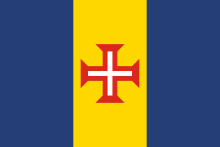The Madeira's southwest coast describes goals Madeira in the "lower left" area of the island. Next Caniço Most of the accommodation options of every type and price range can be found in this area. Most of the German-speaking residents are believed to be here. Exploring the entire island is possible without any problems, even if a rental car would be the best option.
Regions
The southwest is administratively comprised of the administrative districts of Ribeira Brava, Ponta do Sol and Calheta. Levada walks that are easy to reach can also be undertaken here in coastal areas. Bathing opportunities can be found in mostly stony bays along the entire coast, sometimes also in the core of the coastal towns with beach promenades and the corresponding infrastructure. In Calheta a small lagoon was created with sand from the Sahara, so that here apart from Porto Santo the only sandy beach on the island is located.
places
- Ribeira Brava is one of the largest places along the south coast and an important transport hub. Here the coastal motorway divides into the strand that runs along the south coast to Calheta and the connection to the north, which connects the place with one of the longest tunnels in Madeira Sao Vicente connects.
- Ponta do Sol is a tranquil fishing village with a small beach bay and a rock pier jutting out into the sea, which offers wide views over the south coast. There is also a small marina with beach facilities in Lugar de Baixo.
- Madalena do Mar, small coastal town without its own bay and therefore with rather rougher bathing opportunities.
- Calheta offers next to the sandy beach also the largest settlement area of the southwest together with the gradually growing together neighboring communities Arco do Calheta and Estreito do Calheta. A sports port and a flight school guarantee appropriate opportunities for action, with the Casa das Mudas also Madeira's museum for modern art is located here.
- Prazeres is a popular starting point for levada hikes or to Paúl do Mar and currently the western end point of the coastal motorway.
- At the lighthouse of Ponta do Pargo you can see the Atlantic from the westernmost point of the island.
Other goals
Several country roads, some of which are still adventurous today, lead from the southwestern coastal area to the plateau Paúl da Serra. Even if these places belong to the administrative area of the municipalities described, they are listed in this wiki under the region Central highlands and mountains described.
getting there
Most vacationers are on Madeira's only one Airport arriving in Santa Cruz. From there, package tour operators offer direct transfers to your place of residence. Individual tourists take over their rental cars here or use the airport buses Funchal. The ER 101 coastal motorway, which is heavily tunneled under, allows you to reach every coastal town with your own vehicle within a maximum of one hour. Particularly in the southwest, individual accommodations can also be located in the foothills or the beginning of the high mountains, for which good local knowledge and significantly more travel time must be planned.
mobility
As a rule, your own rental car is the best alternative in this area.
Public bus transport is managed by the operator Rodoeste and offers frequent and fast connections to the capital along the Calheta - Ribeira Brava axis Funchal. Apart from that and also to the north after Porto Moniz the offer is usually limited to 2-3 connections per day, the timing of which is also based on the needs of working people and schoolchildren.
For hikers there are individual taxi companies who specialize in a drop-off and pick-up service for this clientele.
kitchen
nightlife
Real night life takes place in the capital, Funchal. Locally most likely in the hotel complex of the Hotel Resort Calheta Beach or in smaller pubs in the coastal communities.
security
The emergency number 112 is also used in Madeira.
climate
The average maximum daily temperature fluctuates between 19 degrees in December and January and 25 degrees in July and August. Usually it rains more often in the northern part of the island than in the south. This fact has led to the construction of the typical levadas, which are supposed to direct the water from the rainy northern regions to the south. Ultimately, however, there are many typical microclimates on Madeira. This means that the current weather situation at any point on the island can be completely different from what the viewer's current position would suggest. In Madeira, you are never safe from surprises, both positive and negative.
literature
Web links
- Official Madeira Tourism Website
- Travel and hiking reports of the first author

